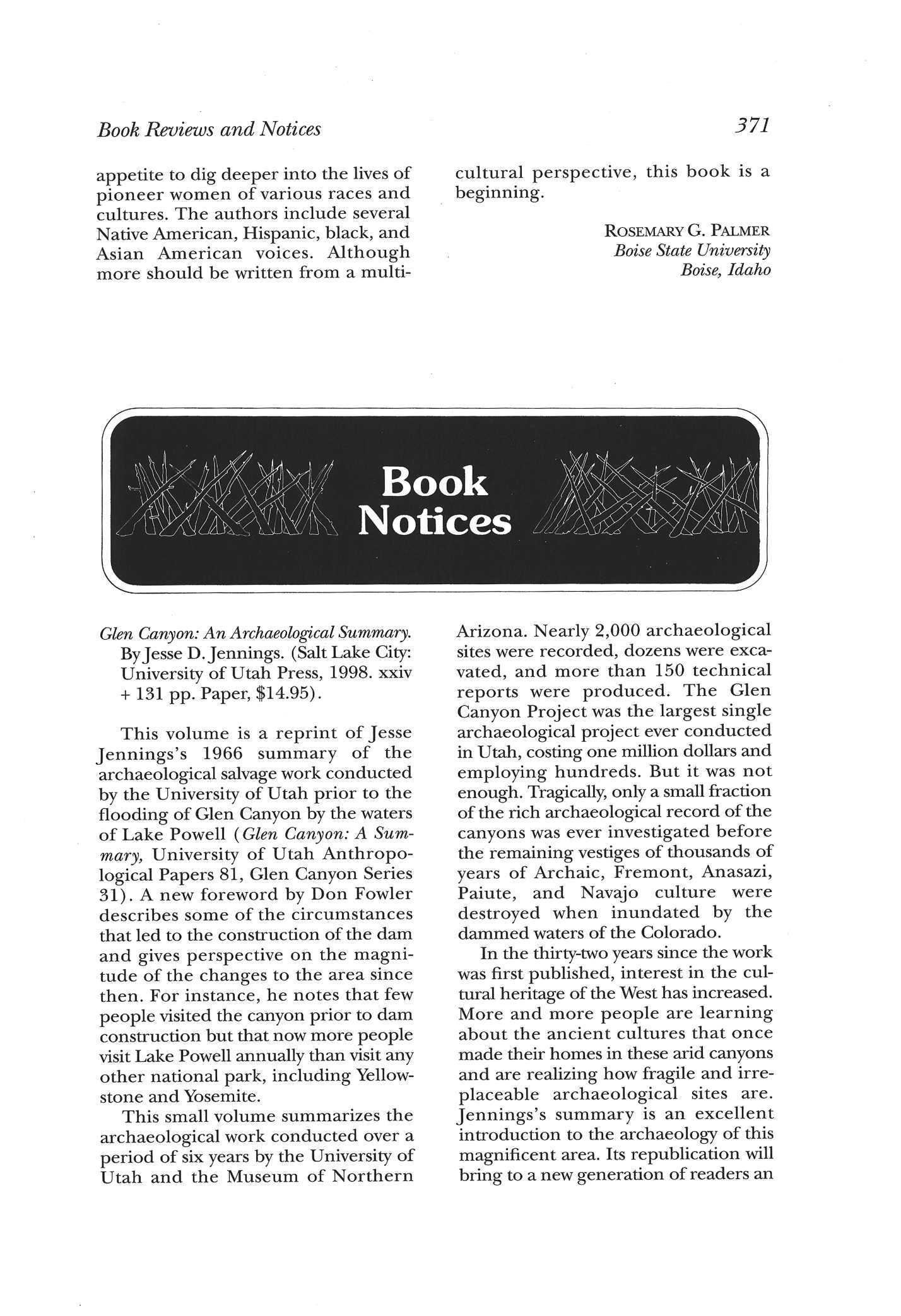
5 minute read
Book Notices
Glen Canyon: An Archaeological Summary.
ByJesse D.Jennings. (Salt Lake City: University of Utah Press, 1998 xxiv + 131 pp. Paper, $14.95).
This volume is a reprint of Jesse Jennings's 1966 summary of the archaeological salvage work conducted by the University of Utah prior to the flooding of Glen Canyon by the waters of Lake Powell (Glen Canyon: A Summary, University of Utah Anthropological Papers 81, Glen Canyon Series 31). A new foreword by Don Fowler describes some of the circumstances that led to the construction of the dam and gives perspective on the magnitude of the changes to the area since then For instance, he notes that few people visited the canyon prior to dam construction but that now more people visit Lake Powell annually than visit any other national park, including Yellowstone and Yosemite.
This small volume summarizes the archaeological work conducted over a period of six years by the University of Utah and the Museum of Northern Arizona. Nearly 2,000 archaeological sites were recorded, dozens were excavated, and more than 150 technical reports were produced. Th e Glen Canyon Project was the largest single archaeological project ever conducted in Utah, costing one million dollars and employing hundreds But it was no t enough Tragically, only a small fraction of the rich archaeological record of the canyons was ever investigated before the remaining vestiges of thousands of years of Archaic, Fremont, Anasazi, Paiute, and Navajo culture were destroyed when inundated by the dammed waters of the Colorado.
In the thirty-two years since the work was first published, interest in the cultural heritage of the West has increased. More and more people are learning about the ancient cultures that once made their homes in these arid canyons and are realizing how fragile and irreplaceable archaeological sites are Jennings's summary is an excellent introduction to the archaeology of this magnificent area. Its republication will bring to a new generation of readers an appreciation for and understanding of archaeological treasures which, for the most part, no longer exist.
Old Fences, New Neighbors.
By Peter R Decker (Tucson, University of Arizona Press, 1998. 160 pp. Cloth, $40; paper, $19.95.)
There is probably not a place in the West that has not been rocked by change in recent years Growth has blindsided many towns, leaving residents not exactiy sure of what happened.
Old Fences, New Neighbors tells what happened in Ouray County, Colorado But the basic themes of this story could apply to any western community. The book narrates the evolution of place, from the time when the Utes were shoved out to make room for newcomers and new ways until the present— when, in a way, it is the same story, only with different players.
Through the years, national events have powerfully influenced this corner of the West The use of the land has changed according to society's changing needs and desires, and the less powerful are continually supplanted by the more Ralph Lauren's kingly retreat in Ouray County, land where once cattle ranchers worked long hours to survive, symbolizes this trend.
Clearly sympathetic to the ranching life threatened by growth, the book vividly describes what has been lost in the last two decades. But neither does it ignore what has been gained. The town of Ridgeway, the author says, is no longer a close-knit community, richly connected to its ranching history, but neither is it the insular place it once was. Pain and division may have followed growth, but "if a community is a place where people struggle in a climate of tolerant discourse toward a set of shared goals, then Ridgeway is today a far stronger, more vibrant and democratic, and certainly far more interesting place than ever before." (158).
Heart of the Circle: Photographs by Edward S. Curtis of Native American Women.
Edited by Sara Day (Washington, D.C : Library of Congress; San Francisco: Pomegranate Artbooks, 1997 128 pp Paper, $29.95.)
Edward Curtis, photographer, friend to John Muir and John Burroughs, winner of accolades from Theodor e Roosevelt, conceived a large mission for himself: During the first quarter of this century he set out to documen t the "disappearing" Indian tribes of North America. However, with only a thirdgrade education, Curtis had no ethnological background, and he has since been roundly criticized for romanticizing his subjects Yet although his photographs are not reliable documents, they remain artistically strong and perennially fascinating.
And the faces are real. Despite the way Curtis staged, costumed, retouched, and soft-focused his images, the faces wear the truths of individual and cultural personalities and experiences.
Heart of the Circle, as the title itself demonstrates, does no t completely avoid romanticization, either But this artfully designed book provides a good cross-section of Curtis's images of women, a description of the photographer's life and work, informative captions, and explorations of the lives of Indian women, both "then" and now.






